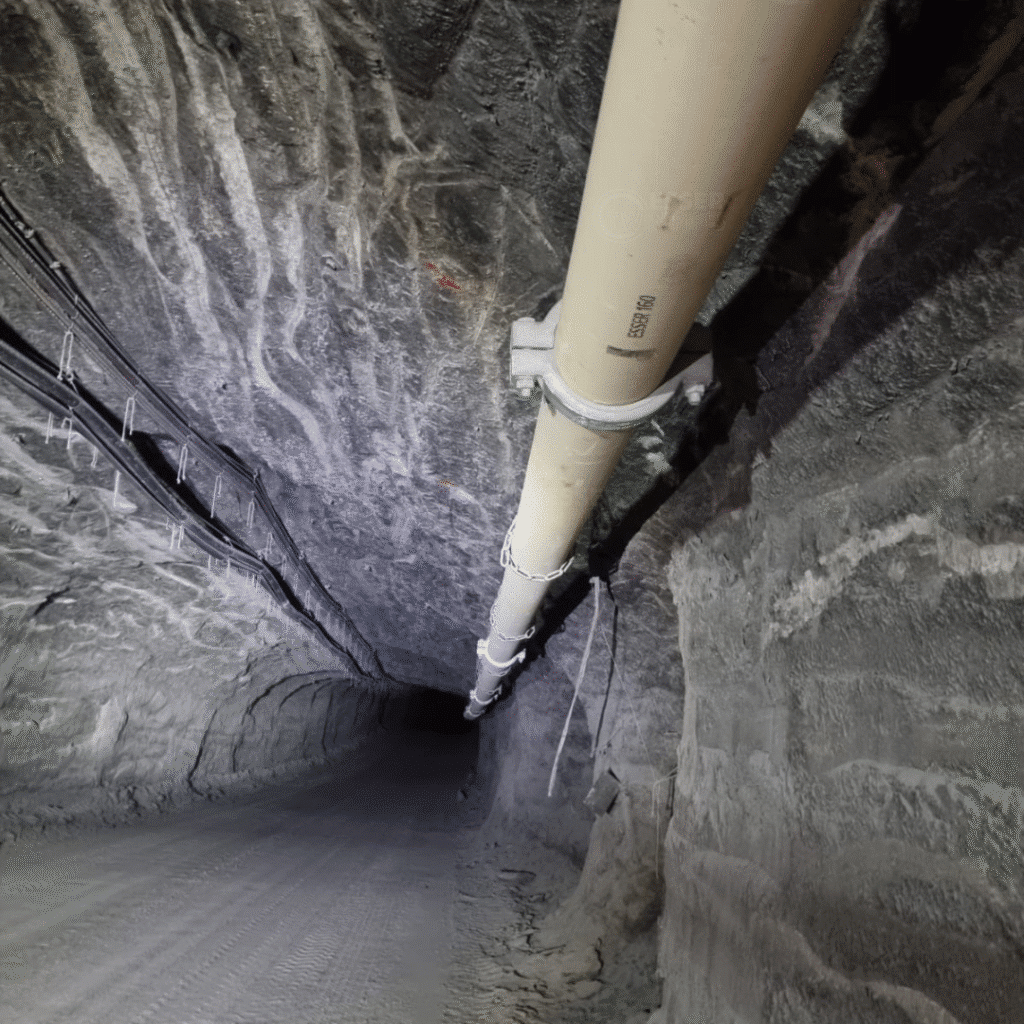Mining operations are incredibly complex, large-scale operations that require safety, precision, and efficiency at every step along the way. One of the greatest challenges in the mining industry is the stabilization of old mining areas. When a deposit is depleted, a hollow cavity remains underground. Weathering processes caused by water or tectonic movements can pose significant hazards to people and the environment above ground.
The mining of underground deposits produces tailings. Tailings are the remains of rocks that are crushed to extract ore. They are typically transported, stored, and often reused to ensure maximum sustainability.
Tailings, as well as non-mining waste (e.g., construction rubble, sludge, or concrete) play an important role in backfilling old deposits. Regardless of how these materials are handled — whether transported pneumatically or hydraulically — the piping and pumping systems used are critical.
Understanding Backfill Media in Mining
Before looking at the most suitable pipes for transporting media in mining, it is important to understand what these substances are, where they come from, and why proper handling is so important.

What are building materials, tailings and non-mining waste?
Building materials (in the form of raw materials, auxiliary construction materials, or semi-finished products) are used to construct structures and buildings. These can be natural materials such as sand, gravel, and crushed stone, or manufactured materials such as cement, concrete, and glass.
Tailings are a by-product of mining; they include mineral residues with no value for production or sale that must be removed from the site. Tailings also arise from the processing of ore-bearing rocks above ground. This by-product is used to backfill unused mine shafts and caverns, allowing mining companies to dispose of their overburden sustainably while simultaneously eliminating a potential hazard.
Non-mining waste is waste that is not directly generated in mining but can be recycled in connection with mining activities. This includes, for example, construction waste, ash, or other materials that can be used in mining as additives for backfilling.
Why Proper Handling Matters
Proper handling of this material is crucial for both regulatory compliance and safety.
The environmental surface should be restored as best as possible after mining is complete. This includes maintaining soil stability to avoid subsidence that could pose a threat to the groundwater level or structural infrastructure. Tailings, non-mining materials, and construction materials are used for this purpose, but improper handling can cause further environmental damage. The transport of these substances must be safe so as not to endanger people or equipment.
How Is This Material Moved?
Let’s take a look at the systems mining operations use to safely transport these materials.
Piping Systems for Pneumatic Conveying
Pneumatic systems are used for dry materials. Air is a convenient conveying medium. Transporting it through pipelines is dust-free, thus preventing cross-contamination. The material being conveyed (a mixture of bulk material and air) is lighter in weight than with hydraulic conveyance. Therefore, these systems are preferred in vertical shafts.
However, conveying with air is energy-intensive, and the conveyed media can cause significant wear. Therefore, the piping must be specifically designed for this task and be wear-resistant. Conventional, mild steel pipes typically wear out significantly faster than wear-resistant, hardened steel pipes, which results in costly downtime and safety risks for employees.
Our double-layer pipes (Esser Twin Pipes 700 and 900 Series) and the single-layer 400 Series offer high abrasion resistance thanks to their hardened inner layer and double-wall construction. These properties enable mining companies to maximize the service life of their piping systems and reduce the risk of failure in areas where downtime is not an option.
Hydraulic Piping Systems
To create a binding material for backfilling, dry bulk materials (overburden and non-mining waste) are mixed with water and a binding agent (cement) in underground mixing plants. This creates a liquid or even pasty medium, which must then be transported to the site. Because liquid and pasty media are heavier, they require different transportation methods. They are typically transported using hydraulic systems. These systems pump the slurry mixtures through pipelines to the underground cavities. The mass hardens at the point of placement, allowing mining companies to stabilize the previously excavated areas, further reducing the risk of collapse and strengthening the structural integrity of the mine as a whole.
The hydraulic conveying systems used in mining must withstand very high pressures (sometimes up to 200 bar) and transport highly abrasive materials. Therefore, the pipes used to transport these materials must be both robust and abrasion-resistant. Esser offers a wide range of abrasion-resistant pipes designed to withstand the extremely abrasive and high-pressure conditions encountered during the paste backfilling process.
Comparison of Conveying Types
Both systems are used in underground conveyance, although the choice of the appropriate system depends on various factors: the material to be conveyed, the conveying distance, the environmental conditions, and safety requirements.
Conclusion
Pneumatic conveying is a good and flexible option for transporting bulk materials from surface to underground, while hydraulic conveying is more energy-efficient and primarily used underground. The choice between the two systems depends on the specific requirements of the application.
What Sets Esser Apart
In an industry where durability and dependability can directly impact both profitability and safety, Esser distinguishes itself not only through product quality but also through our full-service approach. All our products are engineered, tested, and manufactured in-house through proprietary metallurgy, expert welding, and rigorous quality control.
Our manufacturing process starts with sourcing the highest quality steel and ends with a detailed final inspection that includes custom packing and transport. By overseeing every step, we ensure consistent quality and quick delivery, even for highly customized components.
Beyond the hardware itself, we provide consultation and problem-solving to help customers engineer hardened, abrasion-resistant steel piping systems that are tailored to their specific needs. Our ability to deliver turn-key custom components on short notice is a critical advantage in industries like mining, where conditions can change rapidly and downtime can be costly.





